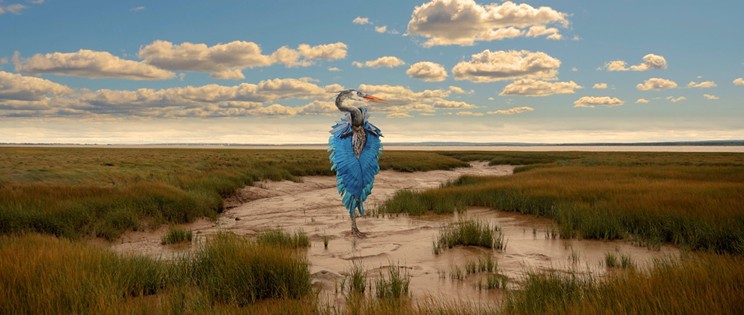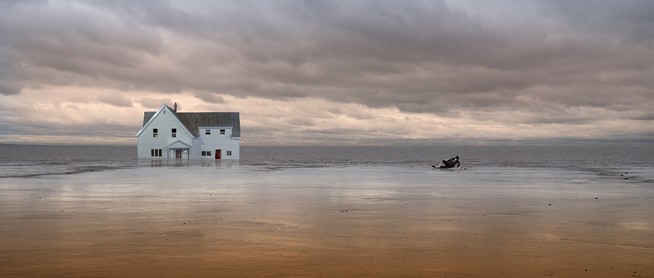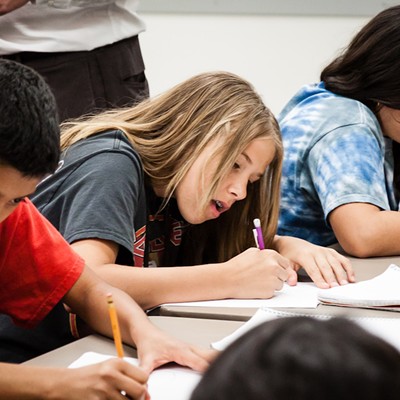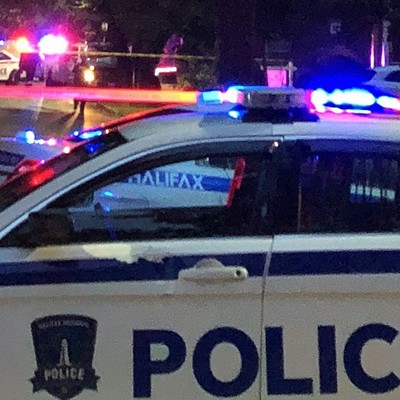Graeme Patterson has built a new world of maturing dreams, fears and anxieties that can be experienced in many forms.
Up now at the Dalhousie Art Gallery and showing until Nov. 10, Strange Birds is the Sackville, NB artist’s third thematic show. Organized and circulated by the Beaverbrook Art Gallery and Dal AG, curated by Ray Cronin, Strange Birds draws together multiple perspectives to untangle Patterson’s fears of a future flooded land. Through sculptural installations of the artist's house built to 1:10 scale, video projections, an atmospheric soundtrack, dancing avatars, virtual reality a video game and more, Patterson transforms a familiar landscape through humour, play, imagination and wonder.
Like the flood, Strange Birds engulfs viewers inside the show's main narrative—acted out in a three-way, cyclical dialogue between his actual house in Sackville, a dancing starling and a witnessing, perhaps mournful, blue heron.
The show revives familiar characters from Patterson's past decade of artwork, which can be considered stand-ins for parts of himself: the house, the starling and the stumps of a tree that fell on his home.
The project began “more internally,” says Patterson, with the house sculpture featured in his art over the years combined with the anthropomorphized dancing starling—a costume he’s performed for a decade. “It’s a character I tie to myself, but it also represents humans in this story,” he says.
In this story, the starling arrives in the house by washing up on the shores of the Tantramar region in New Brunswick, where Patterson lives. However, the setting for this story is before then. “It’s supposed to be ‘untouched land’ at that point, about the colonial history of the area but also the history of the starling itself,” which was brought to North America in 1890 from Germany by a drama-enthusiast “in the name of Shakespeare,” Patterson says. “Now they’re all across the Americas and they’re pretty invasive.”
Continuing the Strange Birds story, the starling arrives, “‘discovers” the land, enjoys its beauty, dances and multiples, “representing their ability to expand quickly and take over,” he says. But then come the warning signs represented by clouds of blue heron wings. There’s another character at play. The blue heron appears in the show, half-performed by Patterson in costume, half-imagined, in a mix of live-action and animation. “It’s supposed to look not-human and like a different kind of creature,” says Patterson. “Hence, the strange birds—one is strange to the region, the other one's not, but it's strange to see and, third, they’re strange to each other.”
In Sackville, where Patterson’s real-life house is, the heron arrives when it does, as a migratory bird. “But it knows the landscape and is coming with the potential of the flood,” which is a representation of Patterson’s eco-anxiety of living in the floodplain “that could potentially separate Nova Scotia from New Brunswick” save for the dikes built by the Acadians.
“I'm predicting what could happen and visualizing it through this narrative that the flood does come and washes away the starling and the house, and it becomes a cyclical narrative so that the blue heron is a warning, but also a witness to this kind of event.”
In part, the narrative can be taken as a colonial history, “but also an awareness of the potential of where we're living, whether it has anything to do with us or it's just the natural part of the landscape,” says Patterson. “Why did we even set our roots there, knowing that the [Bay of] Fundy is quite powerful and maybe never meant for us to plant our roots here?”
This narrative welcomes you into the space through a 30-minute video projection on the gallery wall. It’s also present in virtual form through the experiences that delve into the internal narrative of the starling’s anxieties of losing their home and fears and dreams of the house itself. “That’s a personal narrative that's much more associated with myself,” says Patterson.
The show uses the space of the Dal Art Gallery well, says Patterson, because of how many separate areas can be created to focus on particular elements of the work. “It’s work that requires time,” he says, “and you can enter through any door.”
Patterson says he prefers it that way, for people to draw from their own experience of the show and connect the dots on their own. “It's not a linear narrative at all,” he says. “In a sense, it's a broken, shattered narrative that can be put together through their own experiences, meaning everybody's experience will be completely different.”
He says this is one of the main reasons he included elements like the video game of creating multiple dance moves for the starling character, and the 35 virtual reality experiences that allow each person’s experience of Strange Birds to be entirely their own.
Patterson encourages visitors to look out for QR codes and easter eggs throughout the work; for example, the stumps that some sculptures have been positioned on are part of a tree that fell on his real-life house and led him to worry about this physical anchor.
The show officially opened Thursday, Sep. 5, with Patterson and DAG curator and director Pamela Edmonds welcoming guests into the space.
“I connect to the work through this sense of working through pain, through this idea of joy and through the dance of the starling character throughout the show,” says Edmonds.
“I'm very interested in this idea of how we reconcile ourselves when we feel our environment changing. How do we deal with climate anxiety? How do we deal with these very foreboding questions about what's happening to the earth?
“When I explore issues around racism and other very serious and foreboding issues, I feel, within the Indigenous community and the Black community, humour is a big part of our survival strategy,” she says. “With [Patterson’s] work, I see the use of whimsy and humour to get through some of these serious issues—not to take away from them, but to find a way to say, ‘Okay, things maybe have to go through the cycle that they have to go through.’”
Patterson will give an artist talk in the space on Oct. 17 and a musical performance during Nocturne on Oct. 19.
In the meantime, the Dal Art Gallery is offering free guided tours every Saturday afternoon in September from 2pm to 3pm, led by gallery attendant and intermedia artist and NSCAD student, Geoffrey Webster. registration not required. There is also a show catalogue for sale, designed by Patterson and available for $20 in the gallery, which features accompanying writings by scientist Melanie Zurba, poet Sue Goyette, and Strange Birds curator and director and curator at the Beaverbrook Art Gallery, Ray Cronin.
“By asking [Zurba] and [Goyette] to write for the show allowed us to get voices that are so different—coming from an environmental science perspective, and from what I think is one of the best poetic voices in the country—the texts are very 'not-your-traditional-art catalogue-writing,' except for mine,” Cronin tells The Coast.
The DAG is open Wednesday to Friday, 11am-5pm; Thursday, 11am-8pm; and Saturday and Sunday, 12-5pm. The gallery is always free to attend.












